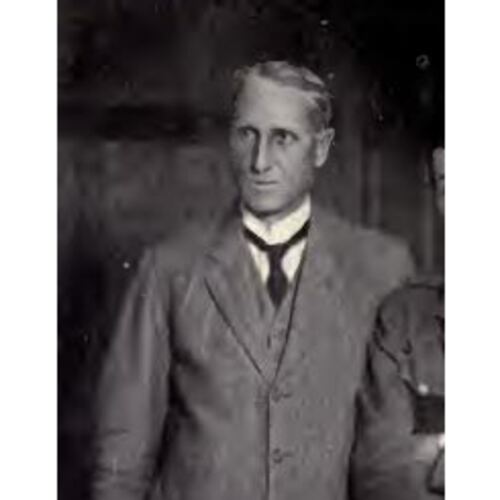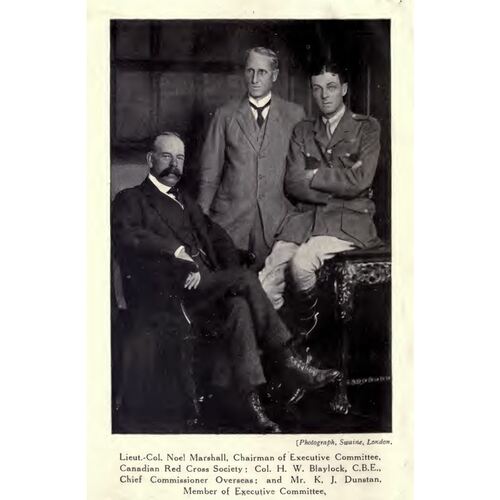![Harry Woodburn Blaylock (detail), in Mary Macleod Moore, The Maple Leaf’s Red Cross: the war story of the Canadian Red Cross overseas (London, [1919]): https://electriccanadian.com/forces/mapleleafsredcross.pdf Original title: Harry Woodburn Blaylock (detail), in Mary Macleod Moore, The Maple Leaf’s Red Cross: the war story of the Canadian Red Cross overseas (London, [1919]): https://electriccanadian.com/forces/mapleleafsredcross.pdf](/bioimages/w600.15226.jpg)
Source: Link
BLAYLOCK, HARRY WOODBURN, lawyer, businessman, and chief commissioner of the Canadian Red Cross; b. 6 Jan. 1878 in Paspébiac, Que., son of the Reverend Thomas Blaylock and Eleanor Mariane Lowndes; m. 30 Sept. 1905 Agnes Georgina Mills in Calgary, and they had one son; d. 25 Jan. 1928 in Montreal.
Harry Woodburn Blaylock was born into the family of a priest of the Anglican diocese of Quebec. He was only 10 when they moved to Danville in the Eastern Townships, where his father had been called to carry on his ministry. He studied at Bishop’s College School and Bishop’s College in Lennoxville, graduating with a ba in 1897. Like many young men of social standing, Blaylock served in the non-permanent militia. He spent the year 1898 with the 54th (Richmond) Battalion of Infantry, whose first company was based in Danville. Military life apparently held little attraction for him, however, and he remained an acting lieutenant for less than a year. In 1900 he enrolled in the faculty of law at McGill University and he completed his bcl with distinction in 1903. During this period he also worked for George Alexander Drummond*, an industrialist in the sugar trade and leading figure in the Bank of Montreal who in addition was an influential senator. Drummond entrusted him with the preparation of legal documents related to his real estate transactions. On receiving a Macdonald scholarship from McGill, Blaylock decided to spend a year studying international law in Paris, in 1903–4. On his return he settled in Montreal, where he embarked on a law career that would prove undistinguished.
It was at this time that Blaylock first met Agnes Georgina Mills, daughter of James Mills, an educator and member of the federal Board of Railway Commissioners. After they were married in 1905, he decided to practise law in Calgary, and he became a founding partner there in the legal firm of Bergeron and Blaylock. In 1907 he suddenly gave up law and moved to London, England, where he involved himself in major construction projects connected with the interests of Sir George Alexander Drummond.
Up to this point, Blaylock’s career had not risen to the heights that a brilliant education and excellent family and political connections might have suggested. It was through an accident of history that his predisposition to action was fully revealed. For some years Blaylock had been acquainted with Lady Drummond [Grace Julia Parker*], Sir George Alexander’s second wife, who was one of the most active women in the Canadian Red Cross Society. When World War I broke out, he offered his services to this organization and served for a few months in its London office along with Lady Drummond. The untimely death of its chief commissioner, Lieutenant-Colonel Jeffrey Hale Burland*, in October 1914, and his replacement by his deputy, Lieutenant-Colonel Charles Alfred Hodgetts, opened the way for Blaylock to become deputy commissioner.
In this capacity Blaylock was put in charge of the society’s operations in France. His duties included supervising the transport of humanitarian aid and providing services for Canadian soldiers (and occasionally for French civilians). The Red Cross made a wide range of services available and distributed all sorts of goods, from cigarettes, clothing, and food to medical instruments and supplies, and complete equipment for dressing stations. It even set up ambulance convoys, an especially important initiative since evacuation of the wounded, which had previously been neglected, changed considerably during World War I, thanks largely to the Red Cross. The rapid and comfortable transfer of wounded men from the front line to the rear would be one of the decisive factors in significantly reducing the mortality rate.
Blaylock based his task of logistical supervision on a simple maxim: “When help [is] needed it must be given and given speedily.” During the first months of the war, he administered aid from the Canadian public through his charitable agency as did others at the time, though on a much larger scale. The work of the Red Cross took a more dramatic direction, however, when the second battle of Ypres began in April 1915. In this first large-scale engagement, Canadians were shelled and gassed, and they suffered heavy losses. The medical posts behind the front lines had no morphine, and it was Blaylock’s organization that would bring 10,000 injectable units up to the front. It was shortly after this experience that the horror of trench warfare was first revealed to him. Victims of gas attacks, men who had lost limbs, and others who were seriously wounded arrived by the hundreds and soon were occupying every available bed in Boulogne, France. Operations during the next 18 months would bring new contingents of suffering humanity. Blaylock was deeply affected by what he saw, but at great personal sacrifice he continued his efforts to ease the suffering of modern war, to the point that he was overcome by fatigue and psychological shock. As a result, he had to stay at Hospital No.14 in Boulogne for three weeks, and then to take three more weeks of rest cure at the end of 1916 and the beginning of 1917 for his nervous prostration.
Once he had recovered, Blaylock resumed his work with vigour and dedication and with a zeal that took him closer to the front than was strictly necessary from any administrative need. When the Red Cross was advised that a large-scale attack was imminent early in April 1917 (it was to take Vimy Ridge), he headed for the main clearing station, where thousands of wounded men soon began to arrive. He was profoundly moved. “Words fail one in trying to describe the horror of it all, but one noticed with wonder and admiration the cheerfulness and self-sacrifice of the wounded. No one seemed so badly hurt but that, in his opinion, the chap next to him was worse, and needed attention first. Men with arms hanging limp were struggling to help men whose legs were wounded; everyone seemed to be thinking of his neighbour.”
When Blaylock was asked to replace Hodgetts as chief commissioner of the Canadian Red Cross overseas in April 1918, his experience made him ready to take on this office. He went back to London, where a much wider range of services was offered than in France. There were, for instance, five hospitals administered by the Canadian Red Cross, a convalescent home for officers, and a rest home for nurses in and around London. Blaylock remained in England after the armistice to put the affairs of the Red Cross in order and wind up the society’s wartime activities. In June 1919, however, this man of average build (at five feet ten and one-half inches and 155 pounds) found his health threatened again, this time by an attack of pleurisy that confined him to bed.
Blaylock received many British and foreign decorations for his wartime services: mention in dispatches (13 Nov. 1916), commander of the Order of the British Empire (7 July 1918), Legion of Honour (knight, 2 May 1917, and officer, 24 Oct. 1919), commander of the Order of the Crown of Italy (8 March 1920), Order of St Sava, 4th class (Serbia, 7 June 1919), and knight by grace and devotion of the Order of Malta (7 Jan. 1920). On 7 Oct. 1918 he had also been made an honorary colonel in the Canadian militia.
Back in Montreal in 1922, Blaylock resumed his place in the business world, as counsel or administrator for the Montreal Development and Land Company Limited and the Westmount Development Company, among others. During the last six years of his life he was involved in the construction and management of commercial and residential buildings in downtown Montreal, Westmount, and Notre-Dame-de-Grâce ward (including Richelieu Place, Chelsea Place, and Trinity Apartments).
Blaylock’s brother, Selwyn Gwillym*, was a metallurgist, and this fact may have influenced the choice of career made by his son, Peter Woodburn; like his father and uncle, Peter would study at Bishop’s College and McGill University, where he obtained a bsc. He went on to become one of the vice-presidents of Shawinigan Chemicals. Harry Blaylock died in Montreal at the age of 50, leaving his wife, son, and brother. Like many of his English Canadian compatriots, he could have used his connections to take command of a unit at the front in World War I. He chose instead to follow Lady Drummond and take up her favourite charity, the Red Cross. In retrospect, this was the right choice, for Blaylock made outstanding efforts to alleviate the suffering of his fellow men.
AC, Bonaventure (New Carlisle), État civil, Anglicans, New Carlisle and Paspébiac Anglican Church, 7 févr. 1878. LAC, RG 150, Acc. 1992-93/166, box 817-1. Alberta Geneal. Soc., Edmonton branch, Alberta: index to registration of births, marriages and deaths . . . (1v. to date, Edmonton, 1995-?), 1 (1870 to 1905). Kenneth Cameron, History of No.1 General Hospital, Canadian Expeditionary Force . . . 1914-1919 (Sackville, N.B., 1938). Can., Dept. of Militia and Defence, Militia list (Ottawa), January 1899, January 1919, December 1922. Canadian Almanac . . . (Toronto), 1875-1912. Canadian annual rev., 1918-19. Canadian men and women of the time (Morgan; 1912). Canadian who’s who, 1910. Andrew Macphail, Official history of the Canadian forces in the Great War, 1914-19: the medical services (Ottawa, 1925). Mary Macleod Moore, The Maple Leaf’s Red Cross: the war story of the Canadian Red Cross overseas (London, [1919]). Nicholson, CEF. Geoffrey Noon, “The treatment of casualties in the Great War,” in British fighting methods in the Great War, ed. Paddy Griffith (London, 1996), 87-112. Standard dict. of Canadian biog. (Roberts and Tunnell), 2.
Cite This Article
Yves Tremblay, “BLAYLOCK, HARRY WOODBURN,” in Dictionary of Canadian Biography, vol. 15, University of Toronto/Université Laval, 2003–, accessed December 31, 2025, https://www.biographi.ca/en/bio/blaylock_harry_woodburn_15E.html.
The citation above shows the format for footnotes and endnotes according to the Chicago manual of style (16th edition). Information to be used in other citation formats:
| Permalink: | https://www.biographi.ca/en/bio/blaylock_harry_woodburn_15E.html |
| Author of Article: | Yves Tremblay |
| Title of Article: | BLAYLOCK, HARRY WOODBURN |
| Publication Name: | Dictionary of Canadian Biography, vol. 15 |
| Publisher: | University of Toronto/Université Laval |
| Year of publication: | 2005 |
| Year of revision: | 2005 |
| Access Date: | December 31, 2025 |





